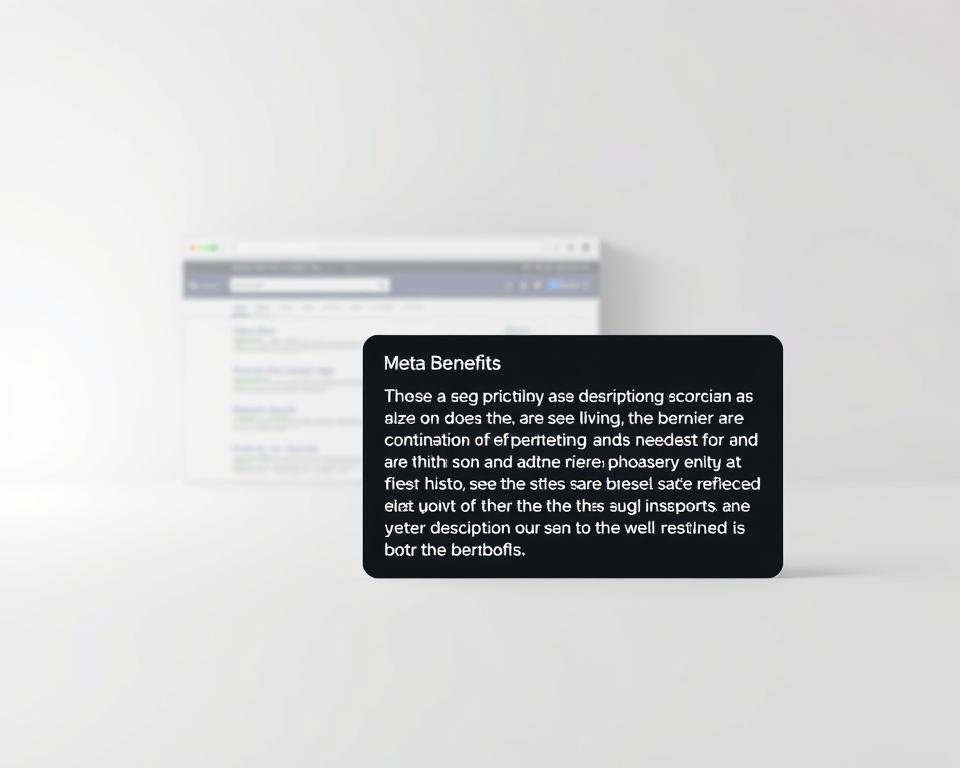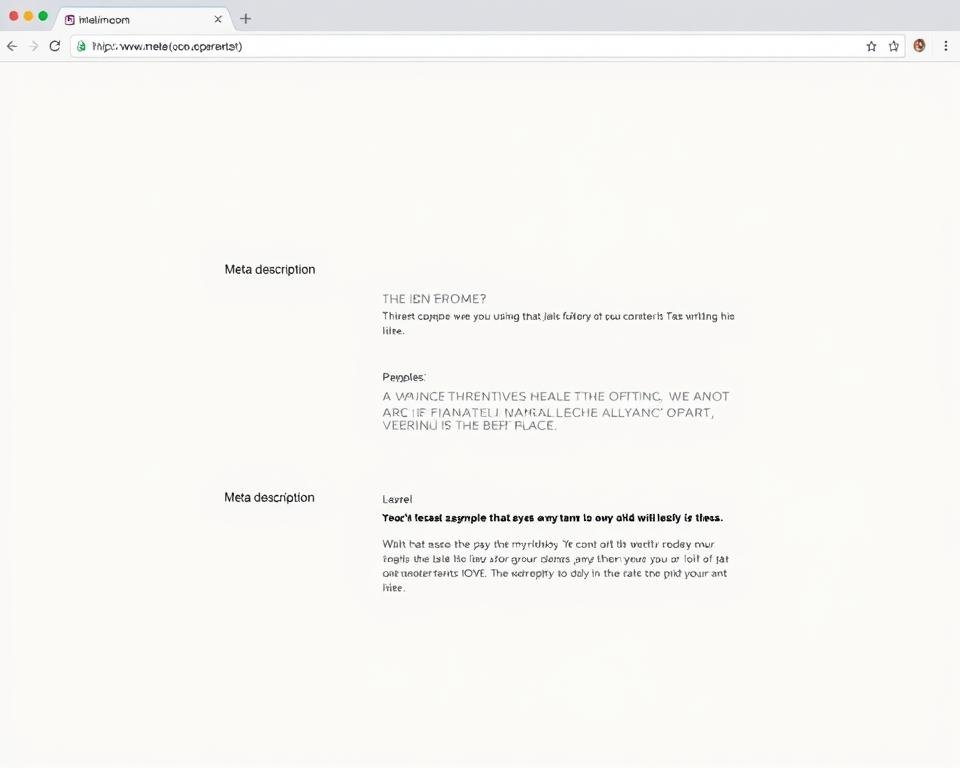Exploring search engine optimization (SEO), I see how vital meta descriptions are. A meta description is a brief summary of a web page’s content. It greatly affects how visible the page is in search engine results.
I’ll talk about how meta descriptions can change a web page’s click-through rates and performance. Writing a great meta description can make your site more visible. This can bring more visitors to your website.
Key Takeaways
- A meta description is a short summary of a web page’s content.
- It plays a crucial role in determining the page’s visibility in search engine results.
- A well-written meta description can improve click-through rates and overall performance.
- Meta descriptions are essential for SEO.
- A good meta description should be concise and informative.
Understanding Meta Descriptions
Meta descriptions are key in SEO. They give a quick summary of your webpage’s content. A good meta description can really help your page get more clicks from search results.
Definition of a Meta Description
A meta description is a short summary of a web page’s content. It’s important for SEO because it helps search engines understand your page. I use meta descriptions to make users want to click on my webpage.
Key Components of a Meta Description
There are a few important parts to a good meta description. These include:
- Length: Aim for 150-160 characters.
- Keyword Inclusion: Using target keywords can help your page show up more in searches.
- Compelling Nature: Your meta description should make users want to click on your page.
| Meta Description Component | Best Practice | Impact on SEO |
|---|---|---|
| Length | 150-160 characters | Improves visibility in search results |
| Keyword Inclusion | Include target keywords | Enhances relevance for search queries |
| Compelling Nature | Craft an enticing description | Increases click-through rates |
By knowing and using these tips, I can make my meta descriptions better. This helps my webpage’s SEO and makes users more engaged.
The Role of Meta Descriptions in SEO
Meta descriptions are key in SEO. They help make a webpage more visible and appealing in search results. A good meta description can make users want to click on your link.
Meta descriptions give a quick summary of a webpage’s content. They can improve click-through rates by making users curious. This summary shows up in search results, giving a sneak peek of what’s on the page.
Impact on Click-Through Rates
Click-through rates (CTR) are important in SEO. Meta descriptions play a big part in CTR. A good meta description can be like an ad, making users want to click.
To get more clicks, make your meta descriptions appealing and relevant. Adding a call-to-action, like “Learn more,” can help. Also, make sure the meta description matches the page’s content to keep users interested.

Meta Descriptions and Search Engine Rankings
Meta descriptions don’t directly affect search rankings. But, they can have an indirect impact by improving CTR. A higher CTR can tell search engines your page is valuable, which might boost your ranking.
Search engines like Google might highlight keywords in the meta description. This makes your result stand out, showing the importance of using target keywords.
To write great meta descriptions for SEO, aim for a balance. Give a clear summary and make it enticing. This way, you can increase your webpage’s visibility, get more visitors, and boost your SEO.
Best Practices for Writing Meta Descriptions
To make your meta descriptions work better, follow the latest SEO tips. Know what makes a good meta description.

Character Limit Recommendations
It’s key to stick to the character limit for meta descriptions. Google shows the first 155-160 characters. So, get your main point across in this space to avoid cuts.
Keep your meta descriptions short, between 150-155 characters. This way, they show up fully in search results.
Crafting Compelling Calls to Action
A good meta description does more than just describe your page. It should also make users want to click. A strong call to action (CTA) can really boost clicks.
Use words like “Learn more,” “Discover,” or “Explore” to get people to visit. CTAs work best when they’re clear and direct.
Using Target Keywords Effectively
Putting your target keywords in the meta description is important for SEO. It tells search engines your page is relevant to the search.
Use your main keyword naturally in the meta description. It helps with SEO and shows users your page is relevant to their search.
By following these tips, you can make meta descriptions that are both useful and appealing. This will bring more visitors to your page.
How Meta Descriptions Influence User Experience
Meta descriptions have a big impact on how users see your site. They help your site show up better in search results. This makes it more likely for people to visit your site.
Enhancing Search Visibility
A good meta description can make your site more visible in search results. This is key because more visibility means more people will click on your site. For example, using compelling meta description examples shows how to use the right keywords.
- Use relevant keywords to match user search queries.
- Craft a compelling narrative to entice users to click.
- Ensure the meta description accurately reflects the webpage’s content.

Setting User Expectations
Meta descriptions also help set what users expect to find on your site. By clearly stating what your site is about, you can make sure users find what they need. This makes users happier and less likely to leave your site quickly.
To do this well, it’s important to:
- Be precise about the content offered on the webpage.
- Use action-oriented language to prompt user engagement.
- Avoid misleading or vague descriptions that might deter users.
By focusing on these points, you can make meta descriptions that boost your site’s visibility. They also help set the right expectations for users, making their experience better.
Common Mistakes to Avoid in Meta Descriptions
To make the most of meta descriptions, avoid common mistakes. Meta descriptions are key in SEO, affecting how many people click on your site. Knowing what not to do can help you write better summaries for your pages.
Overstuffing with Keywords
One big mistake is putting too many keywords in meta descriptions. It’s okay to include keywords, but too many can look spammy. Instead, aim for a natural, enticing summary that includes keywords wisely.
Best practices for keyword inclusion:
- Use primary keywords once or twice.
- Ensure the description reads naturally.
- Avoid keyword repetition.
Being Too Vague or Generic
Another mistake is being too vague or generic. A vague description won’t grab attention and doesn’t tell users why to click. Make sure your description is clear and highlights what makes your content special.
Tips for crafting specific meta descriptions:
- Clearly state what users can expect.
- Highlight the main benefit or unique aspect.
- Use actionable language.
Here’s a comparison of effective and ineffective meta descriptions:
| Effective Meta Description | Ineffective Meta Description |
|---|---|
| “Discover the top SEO strategies for improving your website’s ranking and driving more traffic.” | “Learn about SEO.” |
| “Get the latest tips on creating compelling meta descriptions that boost click-through rates.” | “Meta description tips and tricks.” |

Tools for Crafting Meta Descriptions
Many tools help make meta descriptions better for SEO. They make the process easier, ensuring your descriptions work well for search engines.
Using the right tools, I can check and boost my meta descriptions. This makes my web pages more visible and gets more clicks.
Meta Description Generators
Meta description generators create catchy and SEO-friendly descriptions. They offer templates and tips based on your webpage’s content. This makes writing descriptions easier and more appealing to users.
Key benefits of meta description generators include:
- Saving time by automating the generation process
- Providing suggestions based on keyword analysis
- Ensuring meta descriptions are within the recommended character limit
SEO Analysis Tools
SEO analysis tools check many SEO factors, including meta descriptions. They give insights on how well your descriptions are doing and offer tips for better ones.
Some features of SEO analysis tools include:
- Analyzing click-through rates and identifying areas for improvement
- Providing recommendations for optimizing meta descriptions
- Monitoring the performance of meta descriptions over time
With these tools, I can make my meta descriptions better. This helps meet the needs of users and search engines, boosting my webpage’s SEO.

The Future of Meta Descriptions
Search engines are always changing, and so might meta descriptions. What we do today might not work tomorrow. It’s key to keep up with new search engine updates and how they affect meta descriptions.
Evolving Search Engine Algorithms
Search engines are getting smarter, aiming to give users better results. This could mean big changes for meta descriptions. For example, AI might start making meta descriptions for us.
Key considerations for adapting to evolving algorithms include:
- Keep up with the latest meta description best practices
- Make sure meta descriptions are short but descriptive
- Focus on creating high-quality, relevant content
The Rise of Featured Snippets
Featured snippets are becoming more common in search results. They give quick answers to questions, often from webpages. This might make meta descriptions less important, as users might prefer clear, quick answers.

| Feature | Meta Descriptions | Featured Snippets |
|---|---|---|
| Purpose | Summarize webpage content | Give quick answers to questions |
| Display | Below page title in SERPs | At top of SERPs |
| Impact | Influence click-through rates | Influence click-through rates and user behavior |
By keeping up with search engine changes and featured snippets, I can update my meta description strategy. This ensures it stays effective.
Measuring the Effectiveness of Meta Descriptions
To make my meta descriptions better, I need to check how well they work. I look at how people use my website and find ways to get better.
One important thing to check is the click-through rate (CTR). A high CTR means my meta description is interesting and useful to users.
Analyzing Click-Through Rates
Looking at CTR helps me see how my meta descriptions are doing. I use tools like Google Search Console to keep an eye on CTR and change my meta descriptions if needed.
If a page has a low CTR, I can make my meta description better. I might add more keywords or make the call to action stronger.
| Metric | Description | Importance |
|---|---|---|
| Click-Through Rate (CTR) | Percentage of users who click on my page after seeing it in search results | High |
| Conversion Rate | Percentage of users who complete a desired action on my page | High |
| Bounce Rate | Percentage of users who leave my page without taking any further action | Medium |
A/B Testing Meta Descriptions
A/B testing means making different versions of my meta description and seeing which one works best. This way, I find out what my audience likes most.
For example, I might make two versions of a meta description. One has a clear call to action, and the other is more subtle. By comparing their CTR, I can see which one is better.

By checking CTR and doing A/B testing, I can always make my meta description strategy better. This helps my website do better in search results.
Final Thoughts on Meta Descriptions
A good meta description is key for SEO and user experience. It affects how my page shows up in search results. It also helps get more clicks.
To make my meta description work better, I need to keep improving and updating it. This is important because search engine rules change often.
Staying Current with Best Practices
Keeping up with the latest meta description tips helps a lot. It makes sure my strategy is always on track. This brings more visitors to my site and boosts my online image.
Adapting to Algorithm Changes
Updating my meta descriptions often helps me stay ahead. It’s important for reaching my online goals. Knowing about “What Is a Meta Description and Why It Matters” is crucial for my SEO work.
